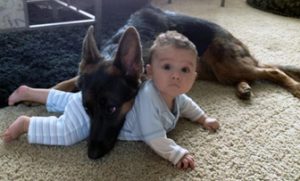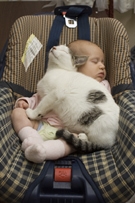Introducing Your Dog & Cat To The New Baby In Your Life
Ron Hines DVM PhD
There was a time when kids came first, and then you got your pets. But times change, and with people marrying later, furry creatures tend to arrive before the babies do. Many of my clients are concerned about how to introduce their blended pets to a new baby when it comes along. It is amazing how intuitive dogs and cats are when it comes to accepting a new baby in the household. You love the child and your pet senses that and will usually cherish the new arrival too. There are, however, a few instances where special care must be taken. Here are some of them:
Introducing Your Dog
Three types of dogs need very special attention in those situations:
Dogs that have already told you that they do not like children. Those are often nervous, fearful dogs with little self-confidence.
A second personality type is the dog that is aggressive toward all strangers that approach or come into your home. Those dogs are assertive and are often owned by owners who let their dogs make all of their own decisions.
The third type of dog is the one that pounces on small furry creatures and chases cats and squirrels. These are predatory personalities – echos back to their wild ancestors.
If your dog fits into one of those three groups, it is a good precaution to keep it on a leash and muzzled when it is near your baby until you know for sure that it will not harm the child. You can never go wrong taking that precaution with any dog of any personality type. If you are fortunate, your dog or cat does not fit into any of those three categories. But pets, like people, can be unpredictable in new situations and caution is always the best approach. Here are some suggestions for introducing your average dog to your new child:
If you want your dog to be under control when it is with your new baby, you need for it to be under your control at all times. That means starting long before your baby comes by teaching your dog to obey your wishes. Enroll your dog in a canine training camp or school. Teach your dog to sit, roll over, heel and lay down on command. This lets the dog know that you are responsible for decision-making – not it. One of the most powerful commands is to train your dog not to eat a treat until you give it the OK. That is an extremely difficult task for a dog. By the time it masters it, it will leave you thoroughly in charge of all the important matters between you and it. Another strong command is to sit patiently even when activity is occurring in the room. Begin by standing at your dog’s side and eventually get to a point where you can leave the room and the dog will continue to sit. Whenever you train your dog to perform these commands, use positive reinforcement such as a pat on the head, a kind word or a treat. Never punishment. Practice the stay command in a room you have set aside for the baby. Some authorities suggest you put a doll in the crib and fuss over it, as if it were the baby. You can do that; but I think dogs are intelligent enough to know the difference. Letting your dog become accustomed to the smell of warm formula is probably a good idea too.
It is a good idea to keep your dog at a friend’s house for a few days when you bring your baby home. You’ll have your hands full with your infant and probably won’t have the time to pet and reassure your dog or prevent jealousy. When you do bring your dog home it will be overwhelmed by all the new odors, exited and hopefully more inclined to cooperate. First let it sniff some of the baby’s used diapers. Then praise and reward your dog. Once it has calmed down, introduce it to seeing-distance of your baby, but on a leash. Then take your dog into your living room and praise and reward it even more. Do this for several days until it becomes routine. When you actually allow your dog to sniff the baby be sure to have several people present to help restrain it should, it becomes necessary. Keep your dog on a leash for better control. If you feel your dog tense up discontinue the introduction and try again later. If you sense the slightest degree of aggression, fear or predatory emotion in your dog, have it wear a comfortable muzzle. For a dog to adjust to the presence of a baby, it needs repetitive exposure to the child in happy situations. That is so that it associates your baby with pleasure. Lavishly praise your dog. Giving it treats during these training period is always desirable. It is always better to be overly safe than foolishly sorry. Place a child’s stair gate in front of your baby’s room to keep the dog out when you are not present. You can gradually relax your supervision as you come to trust your dog.
Introducing Your Cat
Cats are creatures of habit. Your older cat might not be enthusiastic about the new addition – any more than it would be if you brought home another cat. But like a second or third cat, with time they generally get to like (or at least tolerate) babies.
Much depends on the personality of your cat. If your cat is aloof and stand-offish it might simply ignore the baby. However, if your cat is the social type that begs for affection it might feel left out in its new situation. You will probably have less time to play with your cat and meet its social needs. So set aside an hour or two each day to spend just with your cat. Sit on the couch, cat in your lap, reading a book. While you play, introduce your cat to some items of cloths and diapers that have the babies scent on them. Your cat will be very curious at first at these new odors. Once you have set up the child’s nursery room, allow your cat to sniff out all the new furniture and supplies. If you have purchased battery operated toys play them for the cat. As you do all this, give your cat food treats.
There is a misconception that cats dislike babies. They probably do not recognize babies are little people and I have noticed that they treat them more like another object of furniture. That’s not necessarily bad. If you own a shy cat, it will most likely hide for a day or two after you bring the baby home. If it gets particularly piqued it might urinate on piles of the baby’s cloth – but nothing worse. If your cat does get stressed out from the unaccustomed activity, it might over-groom itself or eat a bit less for a while.
When your infant becomes mobile in a wheeled toddler’s chair, your cat will have to learn the art of running away. Usually, they find an inaccessible place to relax: on the dryer or a bookcase, under the bed. That’s fine. It also helps to place an infant gate your cat can jump over across the door of one quiet room. You can also use that room for your cat’s litter box. If your cat has no sanctuaries from children, it will have to learn to be poked and pulled and carried around. Our cat Bubbles, put up with an amazing amount of this from my children. She stoically allowed herself to be just one more child’s stuffed toy taken to bed, eventually sneaking away as my daughter drifted off. It was only when her tail got stepped on that she meowed, hisses and ran away. My youngest child learned to love cat chow. It doesn’t seem to have caused her any harm.
We have all heard medieval folktales about cats smothering babies. There is no truth in that. Cats may not come to the rescue of a baby, but neither would they do anything to intentionally harm one. Cats might be drawn to a baby by the smell of milk formula or plain curiosity. If that should happen, just shoo your cat away from your baby’s crib. You should install an infant monitor. Not because of your cat, just to be safe. Before they existed, others set a few mousetraps upside down under some towels on the floor to “mine” the the crib area for a week or two.
You are on the Vetspace animal health website
Visiting the products that you see displayed on this website help pay the cost of keeping these articles on the Internet.




